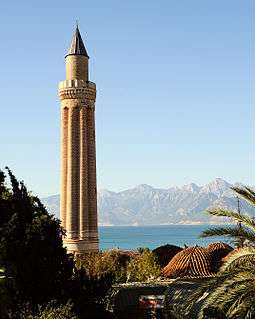Nigar Hatun
| Nigar Hatun نگار خاتون | |
|---|---|
|
| |
| Born | c. 1450 |
| Died |
March 1503 Antalya, Ottoman Empire |
| Burial | Yivliminare Mosque, Antalya |
| Spouse | Bayezid II |
| Issue |
Şehzade Korkut Fatma Sultan Ayşe Sultan |
| Father | Abdullah Vehbi |
| Religion | Islam |
Nigar Hatun (c. 1450 - March 1503,[1]) was the Empress consort of Sultan Bayezid II of the Ottoman Empire.[2]
Life
Little is known of Nigar’s early life. The Ottoman inscription (vakfiye) describes her as Hātun binti Abdullah Vehbi (Daughter of Abdullah Vehbi). On her tomb in Antalya she is described as Hātun binti Abdullah (Daughter of Abdullah) which means that her father was possibly a Christian who converted to Islam.[1][3][4] When Bayezid was still a şehzade ("Ottoman prince") and the governor of Amasya sanjak when she gave birth to Fatma Sultan, followed by the birth of Ayşe Sultan in 1465 and Şehzade Korkut in 1467.[1]
When Mehmed the Conqueror died in 1481, Bayezid moved to Constantinople, the capital of the Ottoman Empire, along with his family to ascend the throne.[1] According to Turkish tradition, all princes were expected to work as provincial governors (Sanjak-bey) as a part of their training.[5] Mothers of princes were responsible for the proper behaviour of their sons in their provincial posts.[5]
In 1481 Korkut, Selim's principal rival, was sent to Manisa sanjak (then known as Saruhan) and then to Anatolia and back to Manisa, and Nigar accompanied him.[5] After the death of Şehzade Korkut, Nigar Hatun came to Antalya in 1513 when her son was executed by Selim. In retirement she occupied herself with pious works.[5]
Burial place
In 1502, just a year before her death, she built a mausoleum for herself at Yivliminare Mosque, Antalya. The style of the mausoleum is reminiscent of the Seljuk vault. It was constructed of aggregate and brick dust and lime mortar on a hexagonal base. The walls are thickly covered in miscellaneous materials. Repairs were carried out on the mausoleum in 1961.
References
- 1 2 3 4 "Turkey: The Imperial House of Osman". web.archive.org. Archived from the original on May 2, 2006. Retrieved 6 February 2014.
- ↑ Ahmed Akgündüz, Said Öztürk (2011). Ottoman History: Misperceptions and Truths. Oxford University Press. ISBN 978-9-090-26108-9.
- ↑ "Consorts Of Ottoman Sultans (in Turkish)". Ottoman Web Page.
- ↑ Anthony Dolphin Alerson (1956). The Structure of the Ottoman Dynasty. Clarendon Press.
- 1 2 3 4 Leslie P. Peirce (1993). The Imperial Harem: Women and Sovereignty in the Ottoman Empire. Oxford University Press. pp. 106–107. ISBN 978-0-195-08677-5.
